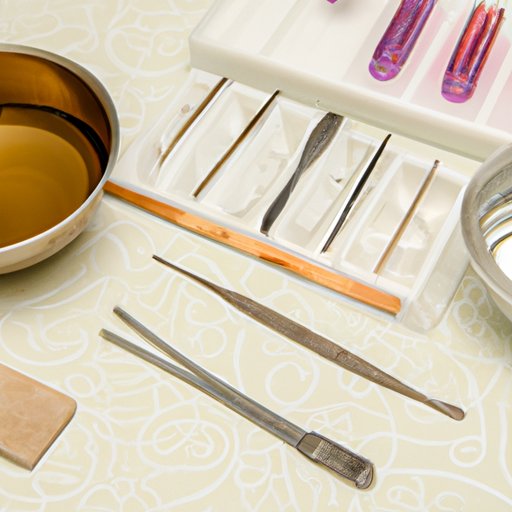Introduction
A splinter is a common type of wound caused by a foreign object entering the skin. These objects typically consist of wood, metal, glass, or plastic, and can cause pain and irritation. Splinters are usually easy to identify and diagnose, but can be difficult to remove due to their size and location. In this article, we will explore the various methods for removing a splinter under the skin, as well as the associated warnings and precautions.
Using Tweezers
Tweezers are one of the most common tools used to remove a splinter. To ensure the tweezers are sanitized and free of contaminants, use rubbing alcohol to clean them before and after use. Once the tweezers are ready, grasp the splinter with the tips and pull it out slowly and gently. If the splinter is difficult to grab, try using a magnifying glass to get a better view. After the splinter has been removed, clean the wound with warm water and soap, and apply an antibiotic ointment to reduce the risk of infection.
Soaking in Warm Water
Another popular method for removing a splinter is to soak it in warm water. The temperature of the water should be between 98-104 degrees Fahrenheit, and the splinter should be soaked for at least 15 minutes. This method works by softening the skin around the splinter, making it easier to pull out. Additionally, soaking in warm water helps to reduce inflammation and pain associated with the splinter.

Applying Heat to the Splinter
Heat can also be used to soften the skin around the splinter, which makes it easier to remove. Common sources of heat include a warm compress, hot water bottle, or a hairdryer. Hold the heat source over the splinter for several minutes until the area around the splinter becomes soft and pliable. After the splinter is softened, gently pull it out with tweezers.
Covering with Glue
This method involves covering the splinter with glue and allowing it to harden. Select an appropriate glue, such as Elmer’s glue or super glue, that is safe to use on the skin. Apply a thin layer of glue to the area around the splinter and allow it to dry completely. Once the glue is dry, the splinter should come out easily with tweezers.
Applying Pressure to the Splinter
Pressure can be applied to the splinter in order to force it out of the skin. This method is best used on shallow splinters and should not be attempted on deep splinters. Options for applying pressure include using a bandage, tape, or credit card. Place the pressure directly on the splinter and hold for several minutes. The pressure should force the splinter out of the skin.
Applying a Poultice
A poultice is a paste made from a combination of ingredients that can help draw out the splinter. Common ingredients used in a poultice include flour, baking soda, and salt. Mix the ingredients together until a paste forms, then apply to the area around the splinter. Allow the poultice to sit for up to 30 minutes, then rinse off with warm water. The splinter should come out with the poultice.
Conclusion
Removing a splinter under the skin can be a tricky process. However, there are several methods available that can help make the process easier. Tweezers, warm water soaks, heat, glue, pressure, and poultices are all potential methods for removing a splinter. It is important to remember to properly sanitize the tweezers before and after use, and to clean the wound afterwards. Additionally, if the splinter is too deep or painful, it is best to consult a doctor for professional removal.


